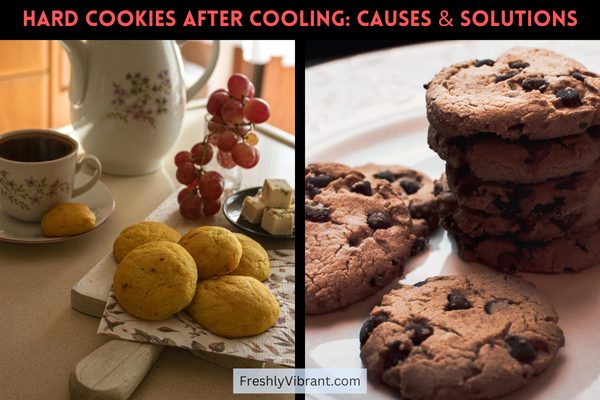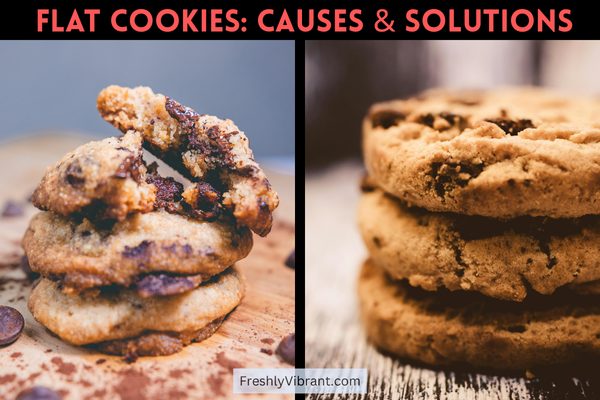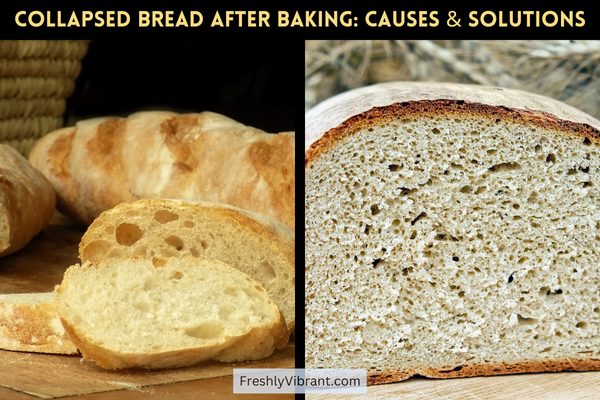Why Are My Brownies Dry? 10 Mistakes and How to Fix Them
“My brownies came out drier than my sense of humor.” If that sounds like you, friend—you’re not alone. There’s nothing sadder than slicing into what should be rich, fudgy goodness… only to meet crumbly, Sahara-like disappointment. 🥲
But fear not! We’ve all been there—standing in the kitchen, mixing with hope and baking with dreams, only for science (or sabotage?) to strike. In this post, I’ll walk you through the sneaky culprits behind dry brownies and what you can do to never suffer through chalky bites again.
Spoiler alert: it’s not always your fault—but sometimes… it is. Let’s dive in, spatulas ready.

You Overbaked the Brownies
I learned the hard way that brownies don’t just stop cooking the moment you yank ’em from the oven. One batch I made looked perfect inside the oven—edges pulling away, top all crinkly and shiny. But 20 minutes later, they were bone dry and borderline inedible. Turns out, like a stubborn toddler refusing bedtime, brownies keep going even after lights out (aka the oven).
Here’s the thing: the pan holds heat. So when you let them sit in that hot pan after baking, they keep cooking. If you’re aiming for fudgy brownies, you gotta pull them before they seem “done.” That toothpick test everyone talks about? Yeah… not always helpful here. If the toothpick comes out completely clean, you’ve gone too far.
What I do now is check for just a few moist crumbs on the toothpick—not raw batter, but not bone-dry either. And I give the pan a gentle jiggle. Slight movement in the center? Good. Overcooked brownies = dry brownies. And nobody’s got time for brownie heartbreak.
Another tip? Cool them on a wire rack and gently lift them out of the hot pan if you can. You’ll lock in the gooey center before the edges start turning into bricks.
Your Oven Is a Liar (AKA: Oven Temperature Issues)
Can we talk about how much ovens lie? I used to trust mine blindly—set it to 350°F, wait for the beep, and pop in my brownies. But when I finally used an oven thermometer? That sucker was running at 375°F the whole time. No wonder my brownies were always dry and a little too crusty around the edges.
Even a 10- or 15-degree difference messes with the baking time for brownies. And most home ovens fluctuate more than you’d think. Hot spots, uneven heating, the whole shebang. That’s why sometimes the edges burn while the middle still looks raw. Super frustrating.
So, I bought a cheap oven thermometer on Amazon and now I always double-check. Sometimes I even preheat my oven for longer than it says—just to make sure the heat is evenly distributed. Oh, and if your brownies bake better on one side than the other? Rotate the pan halfway through.
It’s wild how something as small as oven temp can ruin fudgy brownies. Brownie texture depends on consistency—too hot, and the outsides overcook before the inside sets. Trust me, your oven is not your bestie until you learn how it really behaves.
The Recipe Ratio Was Off
Okay, real talk—measuring with cups is kinda shady. I once added what I thought was 1 cup of flour to my brownie mix. But it turned out I packed the flour too tightly and ended up with way more than needed. The result? Cakey, dry disaster. Not a hint of moist brownies anywhere.
Brownie recipes are delicate little science projects. You mess with the ratio of fat to flour—even a little—and the whole thing goes sideways. Not enough butter or oil? Say goodbye to gooey brownies. Too much dry ingredient? Hello, crumbly sadness.
That’s why I started using a kitchen scale. I know it sounds fussy, but trust me—once you weigh your ingredients, you get consistent results every time. And don’t even get me started on people who skip the eggs or cut back on sugar too much. Sugar holds moisture. Eggs add structure and softness. Tweak those things, and you risk ruining everything.
One last thing—stick to recipes that list weights and volume if you’re not ready to go full-on digital scale. But just know: those measuring cups? They lie almost as much as your oven.
You Didn’t Use Enough Fat
Back when I was trying to make my brownies “healthier,” I thought it’d be smart to swap out half the butter with applesauce. I mean, people do that all the time in muffins, right? Well, turns out brownies aren’t muffins. What I got was a dry, spongy mess that had all the joy sucked out of it. Lesson learned.
Butter and oil are what give brownies their rich, dense texture. You need enough fat to coat the flour and prevent gluten from going wild, which can make your brownies tough. Fat also adds shine, softness, and that magical mouthfeel you get in the best fudgy brownies.
Oil tends to make brownies more moist, while butter gives them that deep, decadent flavor. I’ve found a combo of both works best—like half melted butter, half neutral oil. If you go all applesauce or some other low-fat sub, be prepared for disappointing results.
So next time your brownies come out too cakey or stiff, take a peek at your fat ratio. Don’t skimp! Fat is what separates a gooey brownie from a dry one that nobody wants to finish.
You Overmixed the Batter
Ohhh man, overmixing used to be my signature baking sin. I thought the smoother the batter, the better the brownie. So I’d stir and stir until it looked glossy and perfect. Except… the brownies always turned out airy and cake-like instead of dense and fudgy.
Overmixing whips in air—and air is the enemy of chewy brownies. What you really want is a batter that’s just combined. No need to beat it like you’re training for arm day.
Now I fold the ingredients gently, especially after adding the eggs and flour. Once I can’t see dry streaks of flour, I stop. Even if there are a few tiny lumps, I leave it alone. It’s hard to do at first (especially if you’re a bit of a control freak like me), but it’s totally worth it for that rich, compact texture.
So if your brownies are coming out more like sponge cake than fudge bars, try mixing less. Seriously—pretend you’re afraid of your spoon. That little change made a big difference in how my brownie texture turned out.
Low Sugar or Skipped Eggs? That’ll Do It
Okay, let’s bust a myth: sugar isn’t just for sweetness. It actually plays a huge role in how moist and tender your homemade brownies turn out. I once cut the sugar by half because I didn’t want them “too sweet.” Well, guess what? They were dry, crumbly, and kinda bland. Like, the worst of both worlds.
Sugar holds onto moisture during baking. It helps create that shiny, crackly top, and it even affects how your brownies set. Eggs are just as important—they bind everything together and add richness. Skip them or skimp too much, and your brownies fall apart or dry out fast.
Now, I’m all for tweaking recipes, but some ingredients are non-negotiable. You can try using alternatives like flax eggs or extra yolks, but you gotta understand how they change the final product. Same goes for low-sugar versions—if you’re reducing sugar, you might need to add a little extra fat or liquid to compensate.
Moral of the story? Brownies are a balance. Mess with the sugar content or eggs, and you mess with the magic.
You Let Them Cool Out in the Open (or Too Long)
You ever make brownies that looked perfect fresh out of the oven, only to find them dry and crumbly the next day? Yeah, been there. The issue? I let them cool on the counter uncovered for like an hour. All that steamy moisture just… drifted away into the void.
Cooling is sneakily important. If you leave brownies exposed for too long, especially in dry air or a cold kitchen, they lose moisture fast. I’ve started covering mine loosely with foil or even a clean dish towel while they cool, just enough to trap a bit of steam without making them soggy.
If I know I won’t be serving them the same day, I let them cool about 20–30 minutes, then wrap them in plastic wrap or foil and pop them in the fridge. For longer storage? Freezer all the way. I wrap individual squares and stick them in an airtight container. When I reheat, I zap ‘em in the microwave for about 8–10 seconds with a damp paper towel. Works like a charm.
So if your brownies go hard overnight, blame the air—not the recipe. Treat your brownies like leftovers you care about, and they’ll stay soft, moist, and ready for round two.
You Used the Wrong Pan
Okay, I used to think a pan was just a pan. Brownies go in, brownies come out, right? Wrong. I found out (after burning a whole batch) that the type of pan you use can seriously mess with the baking time for brownies.
Glass pans heat slower but hold onto heat longer. That means your brownies may take longer to bake, but they keep cooking even more after you pull them out. Metal pans—especially light-colored ones—give you more even baking and a better shot at fudgy brownies. But dark metal? That stuff cooks fast. Too fast sometimes. You blink and suddenly the edges are dry, the center is overdone, and you’re sitting there wondering what went wrong.
Oh, and pan size? Total game-changer. If the recipe says 8×8 and you use a 9×13… yeah, it’s gonna be thinner, cook quicker, and probably turn out dry unless you reduce the time. I’ve made that mistake more than once, usually when I couldn’t find the right dish and figured “eh, close enough.”
So don’t underestimate your pan. It’s not just a container—it’s part of the baking equation.
You’re at High Altitude (Baking Rules Change Up There)
I don’t live at high altitude, but I once baked brownies while visiting my cousin in Denver and, wow… they were a disaster. Dry, flat, weirdly crusty around the edges. It was like the air sucked out all the gooeyness I’d worked so hard for.
At high altitudes (above 3,000 feet), everything changes. Water boils at a lower temperature, so moisture evaporates faster. That means brownies dry out quicker if you don’t adjust things like the oven temp, sugar, or liquid. You might need to slightly reduce baking time, increase the liquids, or even add an extra egg depending on your recipe.
Some folks also reduce the leavening agents a bit (like baking powder or soda) because those act more aggressively at altitude. It’s like the science goes rogue up there.
If you bake often at elevation, I’d honestly look for a high altitude brownie recipe or check a conversion guide. Once you know how to tweak things, it’s totally doable. But trust me, if your brownies keep flopping and you’re baking up in the clouds? It’s probably not you—it’s the altitude.
You Reheated Them Wrong
Ever nuke a brownie in the microwave and end up with something that could double as a hockey puck? Been there. Reheating brownies seems simple, but do it wrong and you lose everything good—brownie texture, moisture, even flavor.
Microwaves are fast, but they zap the moisture out unless you take precautions. I use a damp paper towel trick—wrap the brownie loosely and zap it for 10 seconds max. It softens it just enough without drying it out. But honestly? The oven method is way better if you have a few extra minutes.
Just pop the brownie in a 300°F oven for about 8–10 minutes. You can even cover it lightly with foil to prevent over-drying. And here’s a weird but awesome hack: put a little slice of bread in the container with your leftover brownies. The bread goes stale while the brownies stay soft. I don’t fully understand the science, but it works.
If your brownies are already too dry, you can bring ‘em back to life with a drizzle of warm milk, some ice cream, or a quick blast of steam. You don’t have to throw them out. Reviving old brownies is basically a superpower once you figure it out.
Conclusion
So there you have it—ten totally fixable reasons your brownies may be acting more like bricks than bites of bliss. Baking is science, sure, but it’s also a little bit of magic and a lot of trial and error.
Don’t let one dry batch scare you away from baking greatness! Tweak the temps, trust your gut (and your oven thermometer), and remember: fudgy dreams are just one correctly timed bake away. Now go forth and bake moistly!






